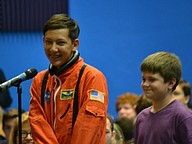- May 7, 2025
-
-
Loading

Loading
Lead Veggie Scientist at NASA Gioia Massa and Veggie Engineer Nicole Dufour inspect the tomato plants in the Pine View School garden.
Lettuce being grown in the Pine View School garden using the Florikan fertilizer.
The garden at Pine View School that is using the same fertilizer that is being used on the International Space Station.
The garden at Pine View School is using the same fertilizer that is being used on the International Space Station.
Lead Veggie Scientist at NASA Gioia Massa explains to students the progress being made to grow edible plants in space.

Eighth grade students T.J. Cochran and Samuel Camilli ask questions to the panel of NASA scientists.
Matthew Mickens a NASA postdoctoral fellow fields a question from Pine View School students.
Pine View School Principal Stephen Colvert and chef Paul Mattison toast with lettuce leafs.
Students listen closely to the panel of NASA scientists during a presentation Friday, Jan. 15 at Pine View School.
The panel of guests included Matthew Mickens a NASA postdoctoral fellow, Plant Physiologist Gary Stutte, Ph.D, Lead Veggie Scientist Gioia Massa, Ph.D, Veggie Engineer Nicole Dufour and Plant Physiologist Raymond Wheeler, Ph.D.
NASA scientists take a tour of the garden at Pine View School that is using the same fertilizer that is being used on the International Space Station.
Students raise their hands during the panel discussion at Pine View School Friday, Jan. 15.
The group of NASA scientists along with Florikan CIO Ed Rosenthal, chef Paul Mattison and students.
Pine View School Principal Stephen Colvert counts the strawberries on a plant.
Pine View School teacher Marybeth Torres toasts with a leaf of lettuce.
NASA scientists landed at the Pine View campus Friday morning for a presentation about the local-made plant fertilizer that is revolutionizing gardens in space and on earth.
Classes of students gathered for the chance to ask questions and listen to how scientists from the NASA Vegetable Production System or “Veggies in Space” has successfully grown a variety of lettuce at the International Space Station. The first success for Veggies in Space came in August 2015 when astronauts harvested "Outredgeous" red romaine lettuce.
Among the guests were Lead Veggie Scientist Gioia Massa, Ph.D., Matthew Mickens a NASA postdoctoral fellow, Veggie Engineer Nicole Dufour, Plant Physiologists Gary Stutte, Ph.D. and Raymond Wheeler, Ph.D.
In the Pine View School garden students have been growing the same varieties of vegetables that astronauts are growing and eating in the International Space Station. They are even Nutricote a time-released fertilizer produced by Florikan, a company based in Sarasota. It’s the same fertilizer that NASA uses in its experiments. Florikan donated the fertilizer for Pine View’s garden and the same type of tomato seeds were planted to match the Veggies in Space program.
Eighth grade student T. J. Cochran dressed for the occasion in a costume astronaut suit to propose his question to the guests. Cochran asked: “ What is the ideal frequency of visible or non-visible light to which you can grow plants best?”
To which NASA postdoctoral fellow Matthew Mickens responded.
“To answer your question as far as which wavelengths work best is actually what I’m doing, investigating what additional colors of light can plants use and whether they can optimize how much they grow as well as the nutrients and antioxidant content,” said NASA postdoctoral fellow Matthew Mickens, Ph.D. “This is actually ongoing research and I’m excited to be a part of it.”
During the presentation students learned the challenges to growing plants on the International Space Station and potentially other planets that include light sources, hydration and zero-gravity conditions.
“I was inspired when I was 12-years-old to come to NASA and to grow plants in space,” said Gioia Massa, Ph.D. and the lead veggie scientist at NASA. “My teacher was invited to Kennedy Space Center and involved in a program about growing plants in space…I was just so excited by that. I really wanted to be able to give that excitement to other students.”
On the ground chef Paul Mattison began involvement with the garden at Pine View this year when his daughter Gianna began attending. He’s also involved with maintaining the garden at Phillippi Shores Elementary School and as seen first-hand what the difference the fertilizer makes in the garden at Pine View.
In December the crops were planted at Pine View and were anticipating a February harvest.
"This garden had plants twice as big as the ones at Phillippi [Shores Elementary]," Mattison said. "We wouldn’t have thought about harvesting until about February but we’ve already harvested. I’m rapidly learning so much about the science of it and it’s amazing."
Scientists tasted the fruits of students' labor with a packed lunch created by Mattison using the vegetables.
"We have about five different varieties of lettuces and two different varieties of kale out of the garden and made a salad along with watermelon radish and quinoa with a little bit of chicken salad with grapes and avocados," Mattison said.